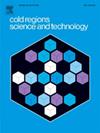高山风电场减冰:自然结冰环境下基于离心力的抛冰策略研究
IF 3.8
2区 工程技术
Q1 ENGINEERING, CIVIL
引用次数: 0
摘要
商业化的公用事业规模风力涡轮机减冰解决方案,如电热和疏冰涂层系统,在高山风力发电场面临重大挑战。电热系统表现出更高的雷击脆弱性,而极端的环境条件加速了涂层的降解,矛盾的是加剧了冰的增加。本研究提出了一种基于离心力的减冰策略,通过在一个正在运行的高山风电场的几台2.5 MW风力涡轮机(wtg)上进行现场实验验证。多维性能评估综合了同步气象监测、SCADA数据分析和不同结冰期叶片根部应变测量。通过应变计进行实际验证,确认在制造商设计的叶片加载限制内操作安全。与传统方法的比较分析表明,所提出的策略减轻釉冰的有效性可与电热系统相媲美,同时在对抗霜冰方面的效率提高13%。与没有除冰策略的涡轮机相比,在雾凇主导的条件下,这种方法的实施将功率损失系数降低了40%,导致每多日结冰事件的最大发电量提高了79,459千瓦时。经济评估显示,年效益在306,833 kWh到3,730,416 kWh之间。这项工作提出了一个基于物理的冰管理范例,解决了现有技术的不同技术限制,并为风电场所有者提供了一个经济有效的山区解决方案,不需要额外的硬件。对于制造商来说,它提供了一个战略途径,以满足不断变化的市场需求,同时提高涡轮机在能源市场上的LCOE竞争力。本文章由计算机程序翻译,如有差异,请以英文原文为准。
Ice mitigation in alpine wind farm: A centrifugal force-based icing-throw strategy study at natural icing environment
Commercialized ice mitigation solutions for utility-scale wind turbines, such as electrothermal and icephobic coating systems, face significant challenges in alpine wind farms. Electrothermal systems exhibit heightened lightning strike vulnerability, while extreme environmental conditions accelerate coating degradation, paradoxically worsening ice accretion. This study proposes a centrifugal force-based ice mitigation strategy validated through field experiments on several 2.5 MW wind turbine generators (WTGs) at an operating alpine wind farm. Multi-dimensional performance evaluations integrated synchronized meteorological monitoring, SCADA data analysis, and blade root strain measurements during various icing episodes. Real-world validation via strain gauges confirmed operational safety within manufacturer's design blade loading limits. Comparative analysis with conventional methods revealed that the proposed strategy mitigates glaze ice with effectiveness comparable to electrothermal systems, while offering a 13 % higher efficacy in combating rime ice. When compared to turbines without a de-icing strategy, implementation of this approach reduced the power loss factor by 40 % during rime-dominated conditions, leading to a maximum electricity yield improvements of 79,459 kWh per multi-day icing event. Economic evaluation showed annual benefits ranging from 306,833 kWh to 3,730,416 kWh. This work presents a physics-based ice management paradigm that addresses different technical limitations of existing techniques, and provides wind farm owners with a cost-effective solution for mountainous regions, requiring no additional hardware. For manufacturers, it offers a strategic pathway to meet evolving market requirements while improving turbine LCOE competitiveness in energy markets.
求助全文
通过发布文献求助,成功后即可免费获取论文全文。
去求助
来源期刊

Cold Regions Science and Technology
工程技术-地球科学综合
CiteScore
7.40
自引率
12.20%
发文量
209
审稿时长
4.9 months
期刊介绍:
Cold Regions Science and Technology is an international journal dealing with the science and technical problems of cold environments in both the polar regions and more temperate locations. It includes fundamental aspects of cryospheric sciences which have applications for cold regions problems as well as engineering topics which relate to the cryosphere.
Emphasis is given to applied science with broad coverage of the physical and mechanical aspects of ice (including glaciers and sea ice), snow and snow avalanches, ice-water systems, ice-bonded soils and permafrost.
Relevant aspects of Earth science, materials science, offshore and river ice engineering are also of primary interest. These include icing of ships and structures as well as trafficability in cold environments. Technological advances for cold regions in research, development, and engineering practice are relevant to the journal. Theoretical papers must include a detailed discussion of the potential application of the theory to address cold regions problems. The journal serves a wide range of specialists, providing a medium for interdisciplinary communication and a convenient source of reference.
 求助内容:
求助内容: 应助结果提醒方式:
应助结果提醒方式:


